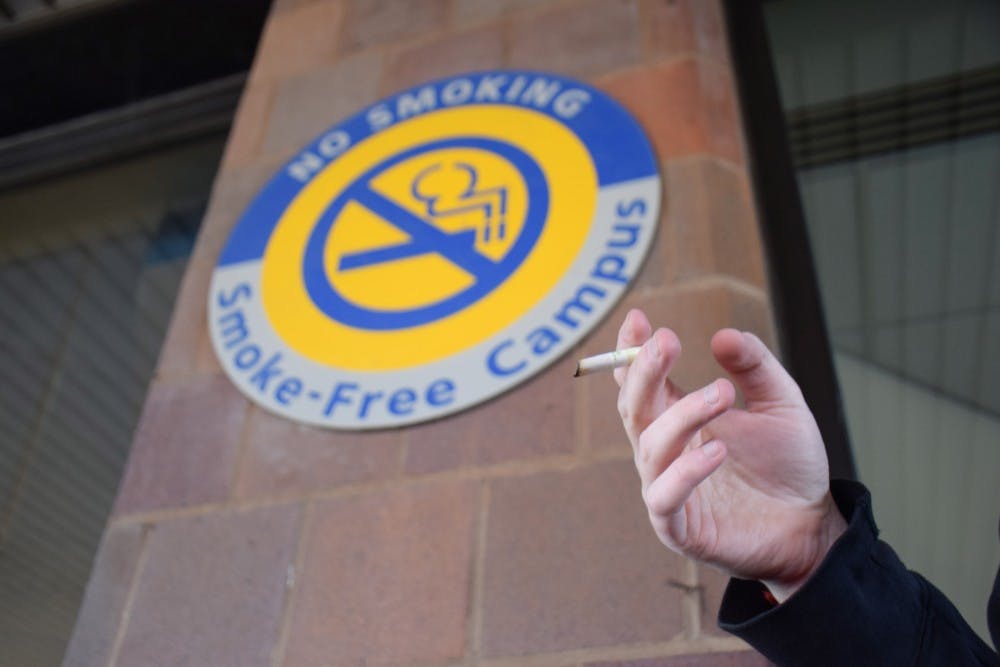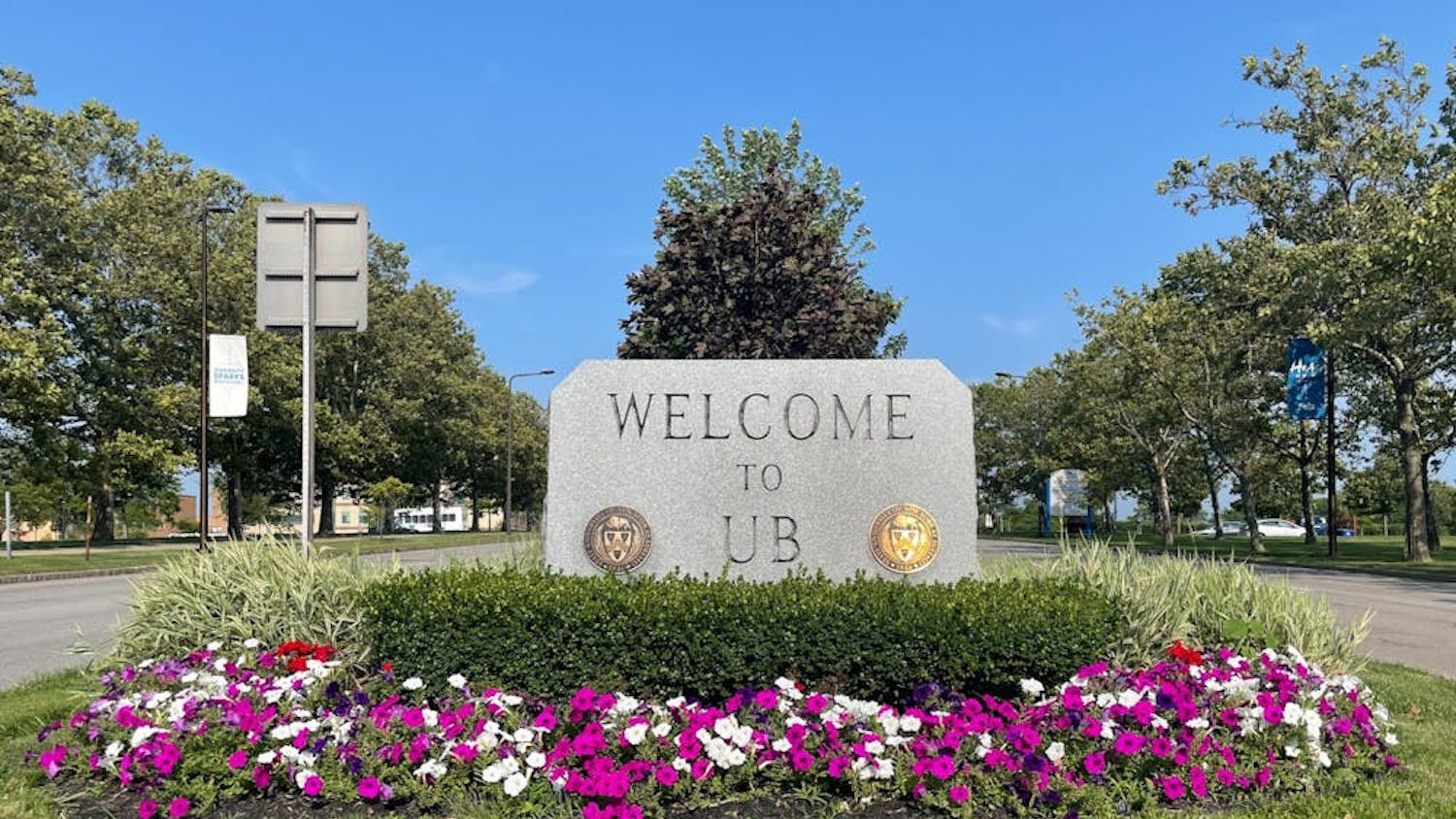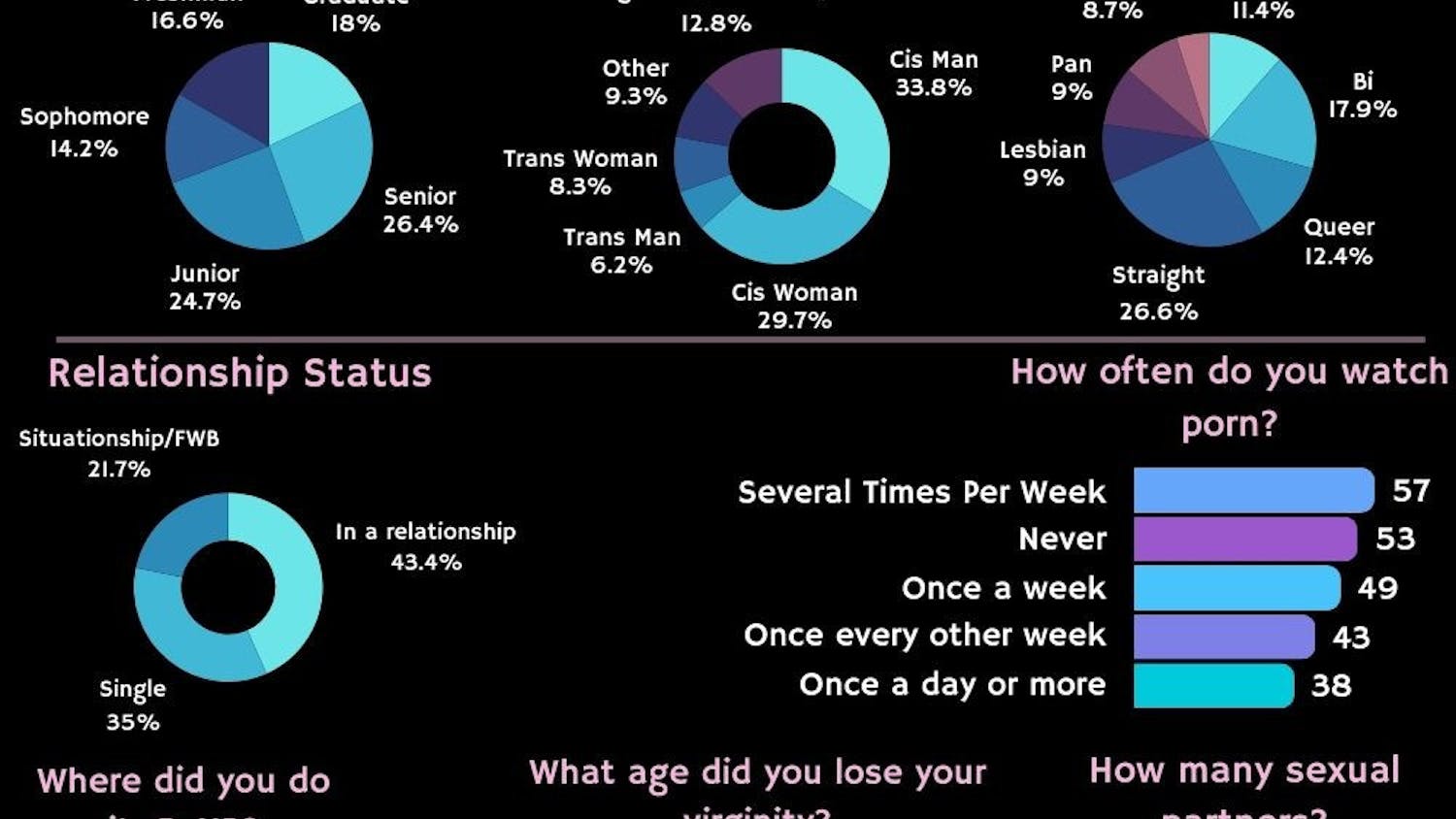Elizabeth Berman, a UB student tour guide gets in “an incredibly awkward situation” when parents and prospective students ask her about UB’s smoke-free policy.
Parents and students are confused when they see people smoking directly under the “no smoking” signs on campus, especially near the Lockwood Library, Berman said.
The current UB Breathe-Free policy established in 2010 is being revitalized to “UB Breathe-Free Now.” Dr. Philip Glick, Faculty Senate chair and Domenic Licata, chair of UB Professional Staff Senate, are working to make an equitable tobacco-free campaign enforceable for everyone. The new campaign will call for stricter implementation for all tobacco-related products and enforcement through education and additional signage.
The current smoke-free policy has been problematic. Children between 21 months and five years are exposed to cigarette smoke every day. Parents, faculty and students support the new policy, but others believe the university should focus their efforts on other issues.
“Having a tobacco-free campus is important I think for everyone at UB,” Glick said.
Glick and Licata thought it would be a “nice public service” and shared governance project to make UB tobacco-free. The campaign is projected to be underway by the spring 2017 semester. Putting up more “no smoking” signs will cost money, but Glick is unsure how much this campaign will cost since they are still in the planning stages.
Glick met with President Satish Tripathi on Oct. 28 and said Tripathi was enthusiastic about the campaign and agreed to appoint the committee.
Three percent of students smoke on a daily basis and 79 percent of UB students have never used cigarettes, according to the 2016 National College Health Association study.
Ninety-two percent of UB students disapprove of smokers throwing cigarette butts on the ground, according to a 2010 myUB Survey.
“All in all we’re not just going to make a new policy but we’re going to create a new mindset and culture at UB that we’re going to be tobacco-free and the mistakes made in the first go-around we’re going to try to fix,” Glick said.
UB became an entirely smoke-free campus in 2009. Designated smoking areas and ash receptacles were eliminated. Later on, CVS in the Commons no longer sold cigarettes.
But students and faculty continue to smoke on campus. If they are caught smoking, students report to Student-Wide Judiciary. They are encouraged to contact the Wellness Education Services and employees are encouraged to contact the Wellness and Work/Life Balance Office for assistance with smoking cessation, according to UB’s smoke-free policy.
Glick said the policy is “good” but in order to have a smoke-free policy, it has to be equal amongst students and faculty. There was no zero tolerance for UB employees because the conditions of employment in employees’ contracts wouldn’t allow for that, according to Glick.
The worst smoking situation at UB is near the Lockwood porch above the UB Early Childhood Research Center, according to Glick. He said it’s inexcusable but he hasn’t contacted the Research Center yet.
Corinne Eggleston, assistant director of the Early Childhood Research Center, thinks smoking is a “huge issue” on campus because children are taking in secondhand smoke.
It’s an issue that has been going on “forever” and hasn’t fully been addressed in the 10 years since she worked at UB, Eggleston said.
“It affects us regularly, on a daily basis, we’re constantly up there reminding individuals to find another place to smoke,” Eggleston said.
Eggleston said she understands why ashtrays were removed as part of the 2010 campaign but the playground is almost always covered in cigarette butts. She said the wind blows all of the cigarettes into the sunken playground area.
Glick said the daycare issue got Tripathi’s attention, “as it should.” Tripathi told Glick he would make sure there will be more signage on the Lockwood porch and he will talk to the UB police to try and enforce it.
Glick said since ashtrays were taken away, people throw cigarette butts on the ground.
Eggleston said some parents are upset and don’t want their children exposed to secondhand smoke.
“The fact that our playground is a sunken playground, all of that polluted air comes down and sits down there, so when we have the kids outside it’s almost constant – the smell of cigarettes down on our playground.” Eggleston said.
It’s something even the children are aware of and used to.
“The children don’t hold back. When they see people smoking, if we walk by them, they’ll tell them,” Eggleston said.
Glick wants to put up more signage and get UB Communication, UB facilities and Gale Bernstein, the health commissioner of Erie County involved in the campaign. Glick said he will try to see if Bernstein can help UB get a policy through the county legislature to put up more signage.
Eggleston said additional signage would be helpful and some parents have offered to pay for it if money is the issue. She also said the benches around the playground are where many students, faculty and staff congregate to smoke. She thinks if those benches weren’t there, some of the smoking would stop.
Glick has spoken with people from Roswell Park Cancer Institute in Buffalo about why their smoking campaign is so successful. He said it was clever of them to ask city legislature to pass a municipal law to smoke and to put a code violation on all of their signs. Glick also met with student life about the campaign and said they were “over the top wanting to get involved.”
“I want to emphasize this UB Breathe-Free version two campaign is trying to be educational and not harsh,” Glick said. “We don’t want to get in anyone’s face. We would really like to change people’s behaviors by education.”
Wellness Education Services provide a walk-in clinic on Thursdays or by appointment to make a smoking plan. They provide free nicotine, gum or lozenges up to roughly eight weeks.
Stacy Liang, a senior anthropology and chemistry major, has been smoking intermittently since she was 11 years old. She generally smokes in a corner by herself outside of Lockwood or when she’s walking from the Student Union to Ellicott.
She said she smokes to alleviate stress but she doesn’t enjoy the taste or smell and she said it’s very expensive.
Upon hearing about children in the research center taking in secondhand smoke, she was upset.
“That really sucks like honestly hearing that makes me really upset because I do know that people do smoke close to the daycare but they shouldn’t,” Liang said.
She was called out for smoking once by an RA in the Ellicott Complex.
Tanja Aho, Graduate Student Association president, said GSA has not been actively involved in the campaign, but would get involved if asked.
However, she feels smoking on campus to be a minor issue in comparison to other issues.
“[The GSA] thinks that while there are certain things that could be done to improve and support students choosing to not smoke anymore, we don’t believe that a stricter enforcement from penalizing perspective is the way to go about it,” Aho said.
She said there are a number of issues that can be addressed. One of the most glaring statistics she’s seen is that over 30 percent of UB students report food insecurity, which she said “is a huge health and safety concern.”
She sees the breathe-free campaign as an important goal but one that should be conceptualized in a much larger framework including asbestos removal, fighting sexual violence on campus and supporting parenting students.
“There are so many issues on campus that we haven’t addressed that would actually improve the health and safety of all UB students, faculty, staff, employees and visitors,” Aho said.
Other students are excited for the campaign.
Michael Brown, speaker of the Student Association Assembly, supports the policy.
“Smokers aren't just putting themselves at risk; they affect everyone around them whether it's college students or children at the daycare,” Brown said. “I think the policy is widely supported, but the challenge is effectively enforcing it. Because the policy is so blatantly violated, particularly near hotspots like Lockwood or Capen, the lack of enforcement is often the butt of jokes among students.”
Brown doesn’t think the issue can be solved by putting more signs up. He served as a UB summer orientation leader and realizes “a lot of campus issues can only be solved by changing the campus culture.”
Glick is interested in getting student help and thinks it’s going to take a “really creative campaign.”
“I think there’s a lot to be done to change people’s mindset and the culture,” Glick said. “We really want to make a new culture at UB that’s tobacco-free and makes the campus cleaner.”
Hannah Stein is the co-senior news editor and can be reached at hannah.stein@ubspectrum.com





